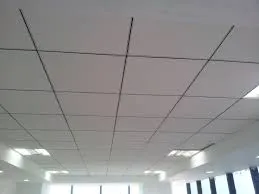Aug . 21, 2024 16:28 Back to list
Guide to Mineral Fiber Acoustic Ceiling Tiles for Enhanced Sound Absorption and Aesthetics
Mineral Fiber Acoustic Ceiling Tiles An Overview
Mineral fiber acoustic ceiling tiles are an increasingly popular choice in both commercial and residential settings. Known for their sound-absorbing properties, these tiles are designed to improve the acoustics of a space while also offering aesthetic appeal and practical benefits. This article explores the composition, advantages, installation, and maintenance of mineral fiber acoustic ceiling tiles.
Composition
Mineral fiber acoustic tiles are primarily made from natural or synthetic mineral fibers, such as fiberglass, gypsum, or other inorganic materials mixed with additives. These fibers are combined with various binding agents and then processed to form a lightweight, porous product. The porous nature of mineral fibers allows them to absorb sound waves, making them effective at reducing noise levels in busy environments like offices, schools, and hospitals.
Advantages
One of the primary advantages of mineral fiber acoustic ceiling tiles is their sound absorption capabilities. They are particularly effective in spaces where noise reduction is essential. By minimizing sound reverberation, these tiles create a more comfortable and productive environment. This is particularly beneficial in open office layouts or public spaces where conversations and activities can lead to elevated noise levels.
In addition to acoustic performance, mineral fiber tiles offer thermal insulation, which can help improve energy efficiency in buildings. They are often treated to be fire-resistant, adding an extra layer of safety. Furthermore, these tiles are available in a wide variety of finishes, colors, and patterns, allowing for creative design possibilities to suit any interior aesthetic.
mineral fiber acoustic ceiling tiles

Another significant advantage is that mineral fiber ceiling tiles are relatively easy to install. They can be suspended from a grid system, making replacement and maintenance straightforward. This is particularly useful for maintaining access to plumbing and electrical systems above the ceiling.
Installation
Installing mineral fiber acoustic ceiling tiles typically involves suspending a grid system from the existing ceiling. Once the grid is in place, the tiles can be carefully laid into the spaces created by the grid. The lightweight structure of the tiles makes them easy to handle, further simplifying the installation process. Professional installation can ensure that the tiles are fitted correctly, maximizing their acoustic and aesthetic benefits.
Maintenance
Maintaining mineral fiber acoustic ceiling tiles is relatively simple. Regular dusting and cleaning can help preserve their appearance and functionality. Most tiles are designed to be stain-resistant, but in the event of significant staining or damage, individual tiles can be easily replaced without needing to remove the entire ceiling system. In addition, since these tiles are often manufactured with anti-microbial properties, they can be an excellent choice for environments that require hygiene, such as hospitals and laboratories.
Conclusion
In summary, mineral fiber acoustic ceiling tiles offer numerous benefits, including sound absorption, thermal insulation, and design versatility. Their ease of installation and maintenance makes them a practical choice for various applications. As the demand for improved acoustic environments continues to grow, mineral fiber acoustic ceiling tiles are likely to remain a significant component in the design of modern spaces. Whether reducing noise in a busy office or enhancing the aesthetic appeal of a home, these tiles are a valuable investment in creating a more pleasant and functional interior environment.
-
Durable Ceiling T Grid Systems | Easy InstallationNewsAug.29,2025
-
PVC Gypsum Ceiling: Durable, Laminated Tiles for Modern SpacesNewsAug.28,2025
-
Pvc Gypsum Ceiling Is DurableNewsAug.21,2025
-
Mineral Fiber Board Is DurableNewsAug.21,2025
-
Ceiling Tile Clip Reusable DesignNewsAug.21,2025
-
Ceiling T Grid Modular DesignNewsAug.21,2025







